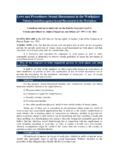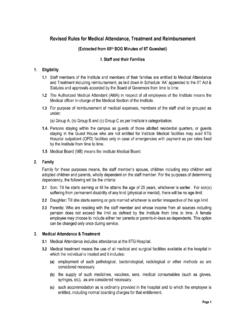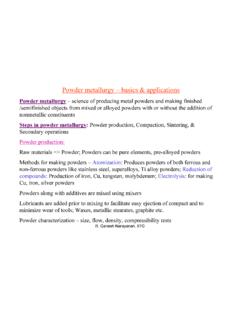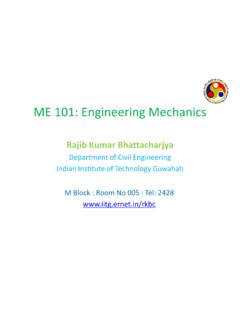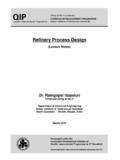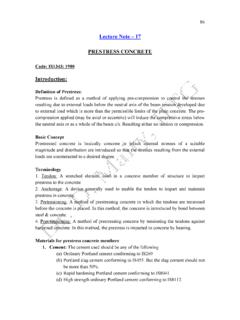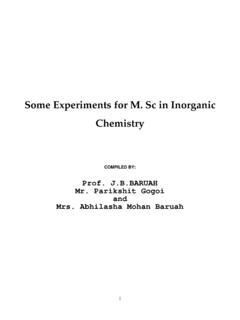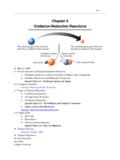Transcription of CHAPTER 12 TWO-DEGREE- OF-FREEDOM-SYSTEMS - iitg.ac.in
1 CHAPTER 12 TWO-DEGREE- OF-FREEDOM-SYSTEMS Introduction to two degree of freedom systems: The vibrating systems, which require two coordinates to describe its motion, are called two-degrees-of freedom systems. These coordinates are called generalized coordinates when they are independent of each other and equal in number to the degrees of freedom of the system. Unlike single degree of freedom system, where only one co-ordinate and hence one equation of motion is required to express the vibration of the system, in two-dof systems minimum two co-ordinates and hence two equations of motion are required to represent the motion of the system. For a conservative natural system, these equations can be written by using mass and stiffness matrices. One may find a number of generalized co-ordinate systems to represent the motion of the same system. While using these co-ordinates the mass and stiffness matrices may be coupled or uncoupled.
2 When the mass matrix is coupled, the system is said to be dynamically coupled and when the stiffness matrix is coupled, the system is known to be statically coupled. The set of co-ordinates for which both the mass and stiffness matrix are uncoupled, are known as principal co-ordinates. In this case both the system equations are independent and individually they can be solved as that of a single-dof system. A two-dof system differs from the single dof system in that it has two natural frequencies, and for each of the natural frequencies there corresponds a natural state of vibration with a displacement configuration known as the normal mode. Mathematical terms associated with these quantities are eigenvalues and eigenvectors. Normal mode vibrations are free vibrations that depend only on the mass and stiffness of the system and how they are distributed.
3 A normal mode oscillation is defined as one in which each mass of the system undergoes harmonic motion of same frequency and passes the equilibrium position simultaneously. The study of two-dof- systems is important because one may extend the same concepts used in these cases to more than 2-dof- systems. Also in these cases one can easily obtain an analytical or closed-form solutions. But for more degrees of 209freedom systems numerical analysis using computer is required to find natural frequencies (eigenvalues) and mode shapes (eigenvectors). The above points will be elaborated with the help of examples in this lecture. Few examples of TWO-DEGREE- of-freedom systems Figure 1 shows two masses with three springs having spring stiffness free to move on the horizontal surface. Let 1 2and mm12, and kkk31 2and xxbe the displacement of mass andm2m1m3k 1k 2m 2k 2x 1x Figure 1 As described in the previous lectures one may easily derive the equation of motion by using d Alembert principle or the energy principle (Lagrange principle or Hamilton s principle) 11mx 11kx1m 212()kxx Using d Alembert principle for mass , from the 1mfree body diagram shown in figure 1(b) 1112122()mxkkxk x++ = 00 (1) and similarly for mass m 22211232()mxkxkkx ++= (2) 22mx 221()kxx 32kx 2m Important points to remember Inertia force acts opposite to the direction of acceleration, so in both the free body diagrams inertia forces are shown Figure 1 (b), Free body diagram towards left.
4 For spring , assuming 2k21xx>, 210 The spring will pull mass towards right by 1m221(kxx) and it is stretched by 21xx (towards right) it will exert a force of 221(kxx) towards left on mass . Similarly assuming 2m12xx>, the spring get compressed by an amount 21xx and exert tensile force of . One may note that in both cases, free body diagram remain unchanged. 212(kxx ) Now if one uses Lagrange principle, The Kinetic energy = 211221122 Tmxmx=+ 2 and (3) Potential energy =221121232111()222 Ukxkxxk=+ +2x (4) So, the Lagrangian 22221122112123211111()222222 LTUmxmxkxkxxkx = =+ + + (5) The equation of motion for this free vibration case can be found from the Lagrange principle 0kkdLLdtqq = , (6) and noting that the generalized co-ordinate 112 and qxqx2== which yields 1112122()mxkkxk x++ = 00= (7) 2211232()mxkxkkx ++= (8) Same as obtained before using d Alembert principle.
5 Now writing the equation of motion in matrix form 1221112232220000kkkmxxkkkmxx+ + + . (9) Here it may be noted that for the present two degree-of-freedom system, the system is dynamically uncoupled but statically coupled. 211 Example 2. Consider a lathe machine, which can be modeled as a rigid bar with its center of mass not coinciding with its geometric center and supported by two springs, . 12,kk In this example, it will be shown, how the use of different coordinate systems lead to static and or dynamic coupled or uncoupled equations of motion. Clearly this is a TWO-DEGREE- of freedom system and one may express the co-ordinate system in many different ways. Figure 3 shows the free body diagram of the system where point G is the center of mass. Point C represents a point on the bar at which we want to define the co-ordinates of this system.
6 This point is at a distance from the left end and from right end. Distance between points C and G is . Assuming 1l2lecx is the linear displacement of point C and c the rotation about point C, the equation of motion of this system can be obtained by using d Alember s principle. Now summation of all the forces, viz. the spring forces and the inertia forces must be equal to zero leads to the following equation. 1122()()ccccccmxmekxlkxl ++ ++= 00 (10) Again taking moment of all the forces about point C 111222()()()GcccccccJmxmeekxllkxll ++ ++= (11) Noting 2cGJJme=+, the above two equations in matrix form can be written as 122211222211112200ccccmmexxkkklklmeJk lklklk l + + + c = (12) 1k k2k cx c 11()cckxl 22()cckxl + G 2l e ccJ C ()ccmxe + 1l Figure 3: Free body diagram of the system Figure 2 212 Now depending on the position of point C, few cases can are studied below.
7 Case 1 : Considering , , point C and G coincides, the equation of motion can be written as 0e= x 11()kxl 22()kxl + 12221122221111220000 GmkkklklxxJklklklkl + + + = (13) So in this case the system is statically coupled and if 1122klk l=, this coupling disappears, and we obtained uncoupled and x vibrations. Case 2 : If, , the equation of motion becomes 2211klkl= 122211220000ccccmmexxkkmeJklk l + + + c=. (14) Hence in this case the system is dynamically coupled but statically uncoupled. Case 3: If we choose , point C coincide with the left end, the equation of motion will become 10l= . (15) 12222222200ccccmmexxkkklmeJklkl + + c =0 Here the system is both statically and dynamically coupled.
8 Normal Mode Vibration Again considering the problem of the spring-mass system in figure 1 with , , , the equation of motion (9) can be written as 1mm=22mm=123kkkk===11212122()02()mxk xxkxmxk xxkx+ += += (16) 213 We define a normal mode oscillation as one in which each mass undergoes harmonic motion of the same frequency, passing simultaneously through the equilibrium position. For such motion, we let 1122,ititxAexA e == (17) Hence, 212212(2)0(22)0kmAkAkAkmA = + = (18) or, in matrix form 212202022 AkmkAkkm = (19) Hence for nonzero values of ( , for non-trivial response) 1 and A2A222022kmkkkm =.
9 (20) Now substituting 2 =, equation yields 23(3)()02kkmm +2= (21) Hence, 131(3) = = and 231(3) =+= So, the natural frequencies of the system and === Now from equation (1)., it may be observed that for these frequencies, as both the equations are not independent, one can not get unique value of . So one should find a normalized value. One may normalize the response by finding the ratio of . 1and A2A12 to AAFrom the first equation (19) the normalized value can be given by 12222 AkkAkmkm == (22) and from the second equation of (19), the normalized value can be given by 2122222 AkmkmAkk == (23) Now, substituting == in equation (22) and (23) yields the same values, as both these equations are linearly dependent.
10 Here, = = (24) and similarly for == = = (25) It may be noted Equation (19) gives only the ratio of the amplitudes and not their absolute values, which are arbitrary. If one of the amplitudes is chosen to be 1 or any number, we say that amplitudes ratio is normalized to that number. The normalized amplitude ratios are called the normal modes and designated by( )nx . From equation (24) and (25), the two normal modes of this problem are: ( ) ( ) == 2 In the 1st normal mode, the two masses move in the same direction and are said to be in phase and in the 2nd mode the two masses move in the opposite direction and are said to be out of phase. Also in the first mode when the second mass moves unit distance, the first mass moves units in the same direction and in the second mode, when the second mass moves unit distance; the first mass moves units in opposite direction.
